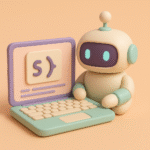
Navigating AI: Empowering Yourself to Master Prompt Engineering and No-Code Solutions for Seamless Automation
In today’s rapidly evolving tech world, Artificial Intelligence (AI) stands at the forefront, offering a plethora of opportunities for innovation and productivity. As someone eager to harness these possibilities, you may find yourself navigating through complex landscapes of AI coding, prompt engineering, and no-code/low-code automation solutions. Here, we aim to guide you through this maze by providing real-world illustrations and sharing insights from our own experiments and experiences.
**Understanding AI Prompt Engineering: A Daily Toolbox**
Imagine a library, filled with books that can talk back to you—this is AI prompt engineering in a nutshell. Just like choosing the right book title gives you the best information efficiently, crafting the right prompts lets AI systems deliver precise outputs. For example, when asking an AI to generate a marketing slogan, the way you phrase your input drastically alters the result. Finding the sweet spot takes practice; try tweaking your prompts iteratively and observe how each change affects the outcome.
**Automation Meets Simplicity: A No-Code Revolution**
Imagine running a restaurant. The chefs create wonderful dishes, but it’s the waitstaff—using a simplified system of ordering and serving—that makes the restaurant efficient. No-code platforms can be likened to that waitstaff, enabling complex automation workflows without the need for intricate coding. Tools like Zapier or Integromat allow you to connect apps with simple logic-based instructions, turning manual tasks into automated ones with just a few clicks. Test these platforms by setting up a basic workflow, then expand based on your comfort level.
**Low-Code: Bridging the Gap for Beginners**
For those willing to dip their toes a bit deeper, low-code platforms offer the best of both worlds: accessible interfaces with the power of custom scripting when needed. Think of this as being able to decide the menu in our restaurant analogy—customizing dishes per customer preferences while maintaining the standard offerings.
**Real-life Example: Building a Personalized Email Assistant**
To illustrate, let’s create a personalized email assistant. We’ll use a no-code tool to automate sorting emails based on urgency, and a low-code platform might allow us to set specific rules for responding to critical messages. Start by concluding which tasks are repetitive enough to automate—perhaps categorizing emails by keywords. Using a platform like Airtable or Notion, build straightforward formulas to tag emails. Then, test and refine the process.
**Bringing It All Together: The Continuous Experimentation Mindset**
Our exploration shows how AI and no-code/low-code tools can transform your workflow—yet it’s not about chasing trends but about consistently experimenting and tailoring the solutions that work for you. Consider starting small, a day at a time, and gradually expanding your toolkit.
**Conclusion: Empower and Equip Yourself**
Utilizing AI platforms might seem mystifying, but as we’ve seen, it’s about crafting and experimenting with simple, iterative steps leading to impressive automation. Our journey here encourages you to embrace these technologies with an open mind, armed with curiosity and a willingness to explore. Dive in, learn, iterate, and most importantly, apply these tools to create solutions that add value to your everyday endeavors.




